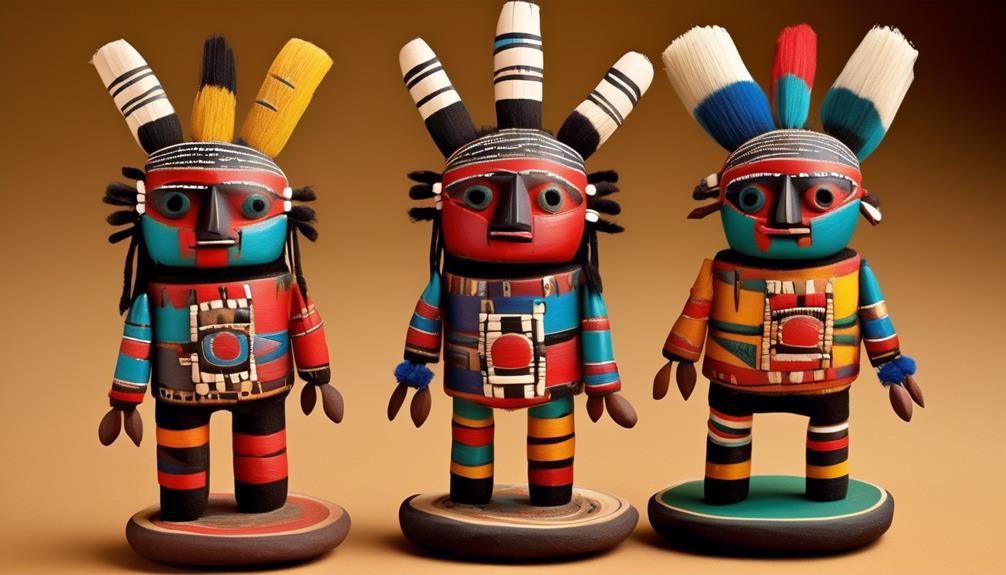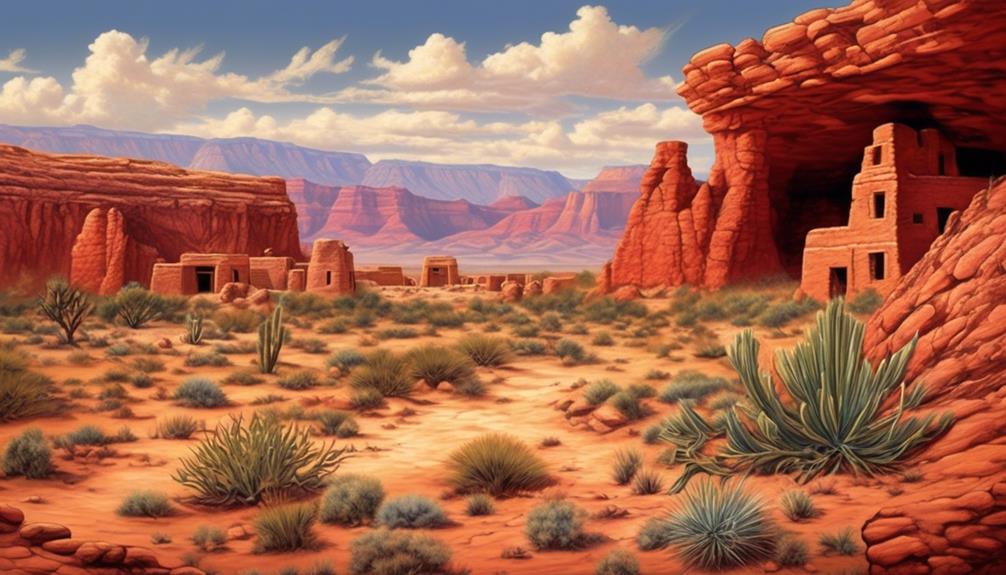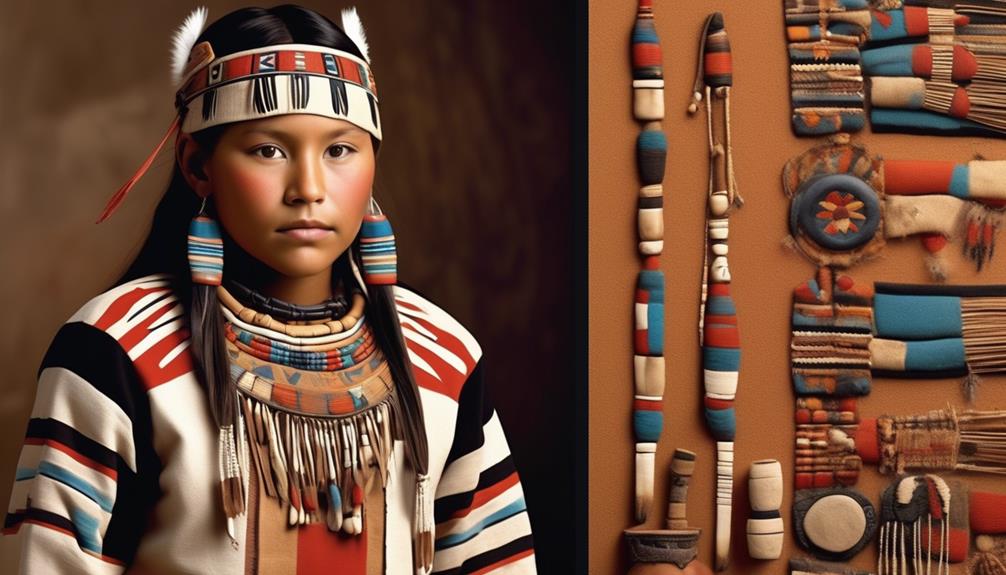Have you ever wondered about the significance of the ceremonial dolls created by the Hopi tribe of Native Americans?
The Hopi Katsinam, also known as Kachina dolls, hold a deep cultural significance and are an integral part of the Hopi people's religious and ceremonial practices.
But what exactly are they, and why are they so important?
Let's uncover the history, meaning, and crafting process behind these enigmatic figures, shedding light on their role in Hopi ceremonies and traditions.
Key Takeaways
- The ceremonial dolls made by the Hopi Tribe are called Katsinam.
- Katsinam have evolved in design and purpose over time and are now also appreciated as collectors' items.
- Katsinam represent a connection to spiritual beliefs and artistic traditions of the Hopi people.
- The crafting process of Katsinam involves using natural materials and offering prayers and songs to honor the katsinam.
History of Katsinam
The history of Katsinam, also known as the Kachina dolls, holds significant cultural and spiritual importance within the Hopi Tribe. These ceremonial dolls aren't just objects of artistic expression; they're symbolic representations of the Katsinam, spirit messengers who are believed to visit the Hopi people and bring blessings, fertility, and guidance. The Katsinam are central figures in Hopi religious beliefs and are revered for their spiritual significance.
Over time, the Katsinam have undergone evolutionary changes in their design and purpose. While traditionally these dolls were crafted as sacred objects for religious ceremonies, in modern times, they've also become collectors' items and are appreciated for their artistic value. However, it's important to note that within the Hopi Tribe, the spiritual significance and cultural traditions associated with Katsinam remain deeply respected and preserved.
Understanding the history of Katsinam provides insight into the rich cultural heritage of the Hopi Tribe and the evolution of these ceremonial dolls, which continue to be honored and valued in both traditional and contemporary contexts.
Cultural Significance
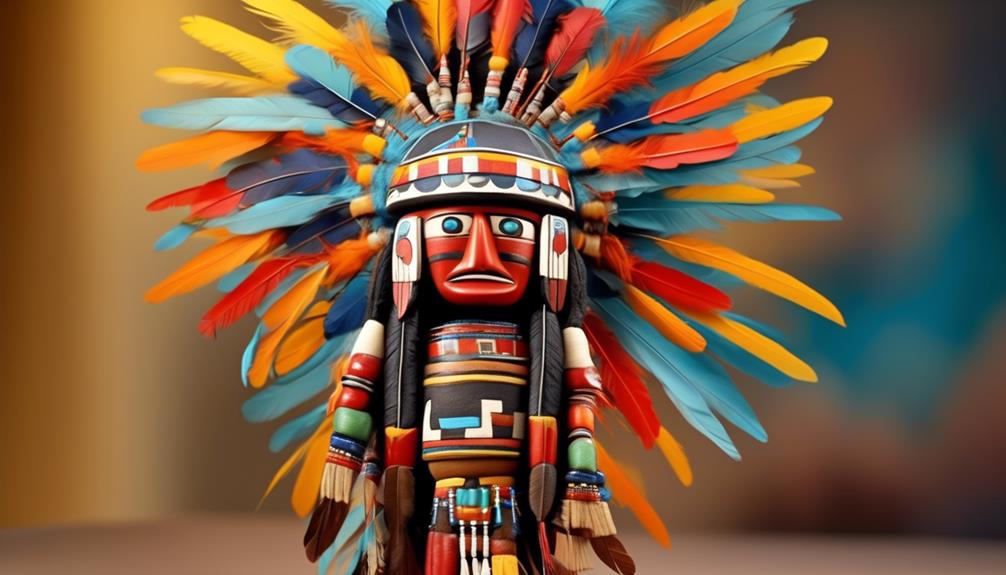
Culturally significant within the Hopi Tribe, Katsinam represent an enduring connection to spiritual beliefs and artistic traditions. These ceremonial dolls hold deep symbolic representation, embodying the essence of the Hopi people's spiritual significance and their profound connection to the natural world. The artistic expression found in the intricate designs of each Katsina doll reflects the tribe's traditional beliefs, passed down through generations, and serves as a testament to their enduring cultural heritage. When one gazes upon a Katsina doll, they aren't just seeing a physical object; they're witnessing the embodiment of centuries-old customs and sacred knowledge.
The symbolic representation of Katsinam invokes a sense of reverence and awe, reminding us of the deep spiritual roots that form the foundation of the Hopi Tribe's existence.
The spiritual significance of Katsina dolls evokes a profound appreciation for the depth of the Hopi people's beliefs and their reverence for the natural world.
The artistic expression seen in Katsinam serves as a poignant reminder of the intricate traditional beliefs and cultural practices that continue to thrive within the Hopi Tribe.
The traditional beliefs reflected in Katsina dolls inspire a deep sense of admiration for the artistic mastery and cultural significance that these ceremonial dolls encompass.
Types of Katsinam
Representing various deities and natural elements, the diverse types of Katsinam are integral to the rich cultural tapestry of the Hopi Tribe. These ceremonial dolls are a symbolic representation of the Hopi people's spiritual beliefs and their connection to the natural world.
The Katsinam are meticulously crafted with artistic craftsmanship, each type portraying a specific deity or natural element. The various types of Katsinam include the Hemis Katsina, representing the spirit of the earth, and the Koyemsi, or mudhead, who embodies the spirits of the ancestors and clowns. Other types include the Ahöla, responsible for bringing rain and guiding the spirits of the deceased, and the Angakchina, who represents the wisdom of the Hopi people.
Each type of Katsina holds its unique significance within the Hopi culture, and the artistic craftsmanship involved in creating these dolls is a revered tradition passed down through generations. The symbolic representation of deities and natural elements through these dolls serves as a means of honoring and preserving the spiritual beliefs and traditions of the Hopi Tribe.
Crafting Process
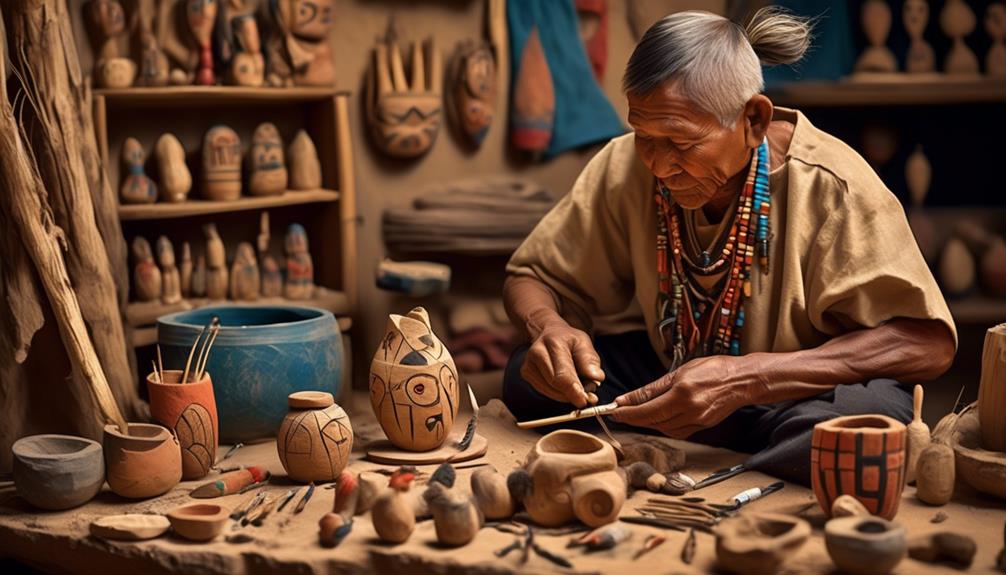
Crafting these ceremonial dolls involves a meticulous process that honors the traditions and spiritual significance of the Hopi Tribe. The dolls are crafted with great care and respect, using natural materials that connect the artisans to the earth and the spiritual realm. The crafting process evokes a deep sense of reverence and tradition, as each step is carried out with utmost mindfulness and intention.
- Materials Used
The dolls are typically crafted from cottonwood roots, which are carefully carved to create the body and head of the figure. Feathers, fur, and other natural materials are then intricately woven and attached to the doll to represent traditional clothing and symbolic elements.
- Traditional Designs
The designs adorning the ceremonial dolls are deeply meaningful, often representing specific katsinam or spiritual beings. These designs are meticulously painted or carved onto the dolls, with each symbol carrying profound spiritual significance for the Hopi people.
- Spiritual Connection
Throughout the crafting process, prayers and songs are offered to honor the katsinam and seek their blessings. This spiritual connection infuses the dolls with a profound sense of sacredness and purpose, making them powerful conduits for cultural preservation and spiritual expression.
Use in Ceremonies
The meticulous crafting process that honors the traditions and spiritual significance of the Hopi Tribe culminates in the ceremonial dolls being utilized in sacred ceremonies and rituals. The ceremonial use of these dolls is deeply rooted in the spiritual beliefs of the Hopi people. They are an integral part of various ceremonies, symbolizing the ancestral spirits and serving as messengers to the spirit world. The table below provides an overview of some of the key ceremonies and the role played by the ceremonial dolls in each.
| Ceremony | Role of Ceremonial Dolls |
|---|---|
| Powamu | Represent katsinam, ancestral spirits who visit the Hopi |
| Niman | Used in dances and rituals to bring rain and ensure fertility |
| Flute Ceremony | Symbolize katsinam and are given to young girls as fertility dolls |
| Bean Dance | Represent katsinam and are used to teach children about the spirits |
The use of these dolls in ceremonies underscores their spiritual significance and the deep reverence the Hopi people have for their ancestral traditions. The ceremonial dolls are not just inanimate objects; they are imbued with the spiritual essence of the Hopi culture, serving as conduits between the earthly realm and the spirit world.
Frequently Asked Questions
How Do the Hopi Tribe Use Katsinam Dolls in Everyday Life and Rituals Outside of Formal Ceremonies?
In modern life, the Hopi tribe incorporates Katsinam dolls into daily rituals and ceremonies, not just formal ones. These dolls hold deep cultural significance and are used to teach traditional values, stories, and ceremonies to younger generations.
They're also utilized in various healing and blessing rituals outside of formal ceremonies, bridging the gap between tradition and contemporary life.
The incorporation of Katsinam dolls in daily rituals reflects the tribe's enduring cultural practices.
Are There Any Taboos or Restrictions Around Who Can Craft Katsinam Dolls Within the Hopi Tribe?
Taboo restrictions play a significant role in the crafting process of katsinam dolls within the Hopi tribe. Only initiated members of specific spiritual societies are allowed to create these ceremonial dolls, ensuring cultural significance and authenticity.
Modern adaptations have seen a shift, with some artists exploring new materials and styles while respecting traditional protocols. This evolution maintains the sacredness of the craft while allowing for creative expression.
What Materials Are Traditionally Used to Make Katsinam Dolls, and Are There Any Modern Adaptations or Changes to the Crafting Process?
Traditionally, katsinam dolls are crafted using materials like cottonwood root, feathers, and natural pigments. While modern adaptations may introduce new tools and techniques, the crafting process changes are made with a focus on preserving the dolls' cultural significance.
Taboos and restrictions guide who can create these dolls, ensuring respect for tradition. Katsinam dolls hold a sacred role in Hopi ceremonies, yet they also find everyday life use as educational tools for teaching cultural values and traditions.
Are There Specific Rituals or Ceremonies Dedicated to the Creation of Katsinam Dolls Within the Hopi Tribe?
Creation rituals within the Hopi tribe hold profound symbolic significance. Through these sacred ceremonies, the katsinam dolls are meticulously crafted, embodying spiritual teachings and cultural heritage.
The meticulous process, steeped in tradition, involves prayers, songs, and offerings, honoring the spirits and ancestors. This ritualistic approach imbues the dolls with a profound spiritual essence, fostering a deep connection to the tribe's beliefs and values.
How Do the Hopi Tribe Preserve and Protect the Cultural Significance of Katsinam Dolls in the Modern World?
Preservation techniques are crucial to safeguard the cultural significance of Katsinam dolls.
Modern adaptations honor traditional crafting process, ensuring the dolls' authenticity.
Our tribe actively preserves and protects these dolls, integrating them into various cultural events and educating younger generations about their importance.
By incorporating contemporary materials and methods, we maintain the dolls' relevance while respecting their heritage.
This approach allows us to honor our ancestors' traditions while adapting to the modern world.
Conclusion
In conclusion, the Katsinam, or ceremonial dolls, are an important part of Hopi culture and tradition. These sacred objects hold deep cultural significance and are used in various ceremonies and rituals.
The crafting process is meticulous and requires great skill.
The Katsinam are a timeless tradition that continues to be an integral part of the Hopi way of life, connecting past and present in a harmonious dance of tradition and modernity.
